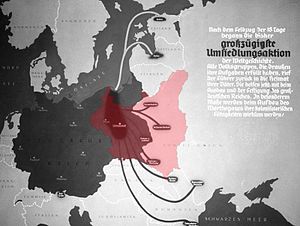重返帝國
此條目可參照英語維基百科相應條目來擴充。 (2023年1月24日) |
重返帝國(德語:Heim ins Reich;意為「回到帝國故土」)是阿道夫·希特勒在第二次世界大戰期間奉行的外交政策。此政策於1938年開始,希特勒的倡議旨在說服所有居住在納粹德國(例如奧地利、捷克斯洛伐克和波蘭西部地區)以外的德意志裔人口努力從這些地區「重返」到大德意志帝國中。他還要求德意志人而且還要從自《蘇德互不侵犯條約》簽訂後不歸屬德國的波蘭東部地區西遷。重返帝國政策的對象主要是《凡爾賽條約》後新生的波蘭以及其他德國大量居民居住的地區,例如蘇台德,但澤以及1939年10月6日以後的歐洲東南和東北地區[2]。
| Heim ins Reich | |
 1939年,第三帝國(灰色)佔領了波蘭(紅色)。此圖示意德意志裔如何自蘇聯的「勢力範圍」遷回[1] | |
| 時間 | 1938–1944 |
|---|---|
| 地點 | 納粹德國佔領的土地 |
| 形式 | 種族清洗與人口轉移 |
| 理由 | 生存空間 |
| 策劃者 | 阿道夫·希特勒 |
這項政策的實施由VoMi(Hauptamt Volksdeutsche Mittelstelle;黨衛隊國外德意志民族事務部)管理。作為納粹黨的國家機構,它處理了所有關於德意志裔問題。到1941年,VoMi已由黨衛軍控制[2]。
歷史
編輯1939年~1944年"重返帝國"在被佔領的波蘭
編輯參見
編輯參考資料
編輯- ^ Lynn M. Tesser. Europe´s pivotal peace projects: Ethnic separation and European integration (PDF). March 2015 Issue 6. European Policy Analysis. [11 January 2017]. (原始內容 (PDF)存檔於13 January 2017).
Heim ins Reich, with approximately 600,000 Germans (Volksdeutsche) moving into designated areas [was approved by Hitler, in] a bevy of population exchange agreements in 1938-40 [including] in a 6 October 1939 Reichstag speech.
- ^ 2.0 2.1 R. M. Douglas. Orderly and Humane: The Expulsion of the Germans after the Second World War. Yale University Press. 2012: 21 [2020-08-25]. ISBN 978-0300183764. (原始內容存檔於2020-02-24).
In a keynote address to the Reichstag to mark the end of the 'Polish campaign', Hitler announced on October 6, 1939 ... the Heim ins Reich (Back to the Reich) program. The prospect horrified many ethnic Germans, much of whose enthusiasm for Nazism had been predicated on the expectation that the boundaries of the Reich would, as in the cases of Austria, the Sudetenland, and Danzig, extend to embrace them. The prospect of being uprooted from their homes to face an uncertain future not even in Germany proper, but in the considerably less salubrious environment of western Poland, was much less attractive. So far from rallying enthusiastically to the Führer's call, therefore, many Volksdeutsche greeted the declaration of the Heim in Reich initiative with a deep sense of betrayal.